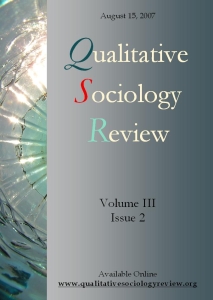Still Killing Mockingbirds: Narratives of Race and Innocence in Hollywood’s Depiction of the White Messiah Lawyer
DOI:
https://doi.org/10.18778/1733-8077.3.2.09Keywords:
Race, Racism, Film, Popular culture, WhitenessAbstract
Through a narrative analysis of movies confronting issues of race and racism in the post-civil rights era, we suggest that the movie To Kill a Mockingbird ushered in a new genre for movies about race which presented an image of a white male hero, or perhaps savior, for the black community. We suggest that this genre outlasted the era of the Civil Rights Movement and continues to impact popular cultural discourses about race in post-civil rights America. Post-civil rights films share the central elements of the anti-racist white male hero genre, but they also provide a plot twist that simultaneously highlights the racial innocence of the central characters and reinforces the ideology of liberal individualism. Reading these films within their broader historical context, we show how the innocence of these characters reflects not only the recent neo-conservative emphasis on “color blindness,” but presents a cinematic analogue to the anti-affirmative action narrative of the innocent white victim.
Downloads
References
Ball, Howard (2000) The Bakke Case: Race, Education and Affirmative Action. Lawrence, Kansas: University of Kansas Press.
Google Scholar
Bakke vs. The Regents of the University of California (1978) Supreme Court of the United States decision 438 U.S. 265, June 28.
Google Scholar
Bobo, Lawrence, James R. Kluegel and Ryan Smith (1997) “Laissez-Faire Racism: The Crystallization of a Kinder, Gentler Antiblack Ideolody.” Pp. 15-44 in Racial Attitudes in the 1990s, Continuity and Change, edited by Steven A. Tuch and Jack K. Martin. Westport, Connecticut: Praeger.
Google Scholar
Bonilla-Silva, Eduardo (2001) White Supremacy and Racism it the Post-Civil Rights Era. Boulder: LynneRienner.
Google Scholar
Bonilla-Silva, Eduardo (2003) Racism Without Racists, Color-Blind Racism and the Persistence of Racial Inequality in the United States. Lanham, Maryland: Rowman & Littlefield.
Google Scholar
Chase, Susan (1995) Ambiguous Empowerment: The Work Narratives of Women School Superintendents. Amherst, MA: University of Massachusetts Press.
Google Scholar
Crenshaw, Kimberle Williams (1988) “Race, Reform, And Retrenchment: Transformation And Legitimation In Antidiscrimination Law.” Harvard Law Review 101:1331.
Google Scholar
DOI: https://doi.org/10.2307/1341398
Delgado, Richard (1996) “Rodrigo’s Eleventh Chronicle: Empathy and False Empathy.” California Law Review 84:61-99.
Google Scholar
DOI: https://doi.org/10.2307/3480903
Dillard, Angela (2001) Guess Who’s Coming to Dinner Now? Multicultural Conservativism in America. New York: New York University Press.
Google Scholar
DuCille, Anne (1994) "The Occult of True Black Womanhood: Critical Demeanor and Black Feminist Studies." Signs Journal of Women in Culture and Society 19(3):591-629.
Google Scholar
DOI: https://doi.org/10.1086/494914
Entman, Robert and Andrew Rojecki (2001) Black Image in the White Mind: Media and Race in America. Chicago: University of Chicago Press.
Google Scholar
DOI: https://doi.org/10.7208/chicago/9780226210773.001.0001
Feagin, Joe (2003) “Foreword.” Pp. vii – xi in Screen Saviors: Hollywood Fictions of Whiteness, edited by Hernán Vera and Andrew Gordon. Boston: Rowman and Littlefield.
Google Scholar
Flagg, Barbara J. (1993) “‘Was Blind But Now I See’: White Race consciousness and the Requirement of Discriminatory Intent.” Michigan Law Review 91:953.
Google Scholar
DOI: https://doi.org/10.2307/1289678
Friedman, Susan Stanford (1995) "Beyond White and Other: Relationality and Narratives of Race in Feminist Discourse." Signs 21(1):1-49.
Google Scholar
DOI: https://doi.org/10.1086/495041
Fusco, Coco (1995) English is Broken Here: Notes on Cultural Fusion in the Americas. New York: New Press.
Google Scholar
Grillo, Trina and Stephanie Wildman (1991) “Obscuring the Importance of Race: The Implication of Making Comparisons Between Racism and Sexism (or Other – isms).” Duke Law Journal 41:397.
Google Scholar
DOI: https://doi.org/10.2307/1372732
Jacobson, Mathew Frye (2006) Roots Too: White Ethnic Revival in Post-Civil Rights America. Cambridge, MA: Harvard University Press.
Google Scholar
DOI: https://doi.org/10.4159/9780674039063
Johnston, Hank (2002) “Verification and Proof in Frame and Discourse Analysis.” Pp. 62-91 in Methods of Social Movement Research, edited by Bert Klandermans and Suzanne Staggenborg. Minneapolis: University of Minnesota Press.
Google Scholar
Hooks, Bell (1992) Black Looks, Race and Representation. Boston: South End Press.
Google Scholar
Lee, Harper (1960) To Kill a Mockingbird. New York: J. B. Lippincott.
Google Scholar
Lipsitz, George (1998) The Possessive Investment in Whiteness. Philadelphia: Temple University Press.
Google Scholar
Madison, Kelly (1999) “Legitimation Crisis and Containment: The ‘Anti-Racist-White-Hero.’” Critical Studies in Mass Communication 16(4):399-416.
Google Scholar
DOI: https://doi.org/10.1080/15295039909367108
Manley, Theodoric (1994) “Teaching Race and Ethnic Relations: Do The Right Thing.” Ethnic and Racial Studies 17(1):134-163.
Google Scholar
DOI: https://doi.org/10.1080/01419870.1994.9993816
Marx, Leo (1964) The Machine in the Garden. New York: Oxford University Press.
Google Scholar
Massey, Douglas and Nancy A. Denton (1993) American Apartheid; Segregation and the Making of the Underclass. Cambridge: Harvard University Press.
Google Scholar
Miller, Perry (1961) The New England Mind. Boston: Beacon Press.
Google Scholar
Pierce, Jennifer (2003) “Racing for Innocence, Whiteness, Corporate Culture, and the Backlash Against Affirmative Action.” Qualitative Sociology 26(1):53-70.
Google Scholar
DOI: https://doi.org/10.1023/A:1021404020349
Oliver, Melvin L. and Thomas M. Shapiro (1997) Black Wealth/White Wealth, A New Perspective on Racial Inequality. New York: Routledge.
Google Scholar
Pride, Richard (2002) The Political Use of Racial Narratives. Champaign: University of Illinois Press.
Google Scholar
Ross, Thomas (1990) “The Rhetorical Tapestry of Race: White Innocence and Black Abstraction.” William & Mary Law Review 32(1):1-40.
Google Scholar
Schuman, Howard, Charlotte Steeh, Lawrence Bobo and Maria Krysan (1997) Racial Attitudes in America: Trends and Interpretations. Revised edition. Cambridge, MA: Harvard University Press.
Google Scholar
Schwartz, Bernard (1988) Behind Bakke: Affirmative Action and the Supreme Court. New York: New York University Press.
Google Scholar
Shields, Charles (2006) Mockingbird: A Portrait of Harper Lee. New York: Henry Holt.
Google Scholar
Smith, Henry Nash (1950) Virgin land: The American West as symbol and myth. Cambridge: Harvard University Press.
Google Scholar
Vera, Hernán and Andrew Gordon (2003) Screen Saviors: Hollywood Fictions of Whiteness. Boston: Rowman and Littlefield.
Google Scholar
Wilson, Clint C. and Felix Gutierrez (1985) Minorities and Media: Diversity and the End of Mass Communication. Beverly Hills, CA: Sage Publications.
Google Scholar
Downloads
Published
How to Cite
Issue
Section
License

This work is licensed under a Creative Commons Attribution-NonCommercial-NoDerivatives 4.0 International License.











